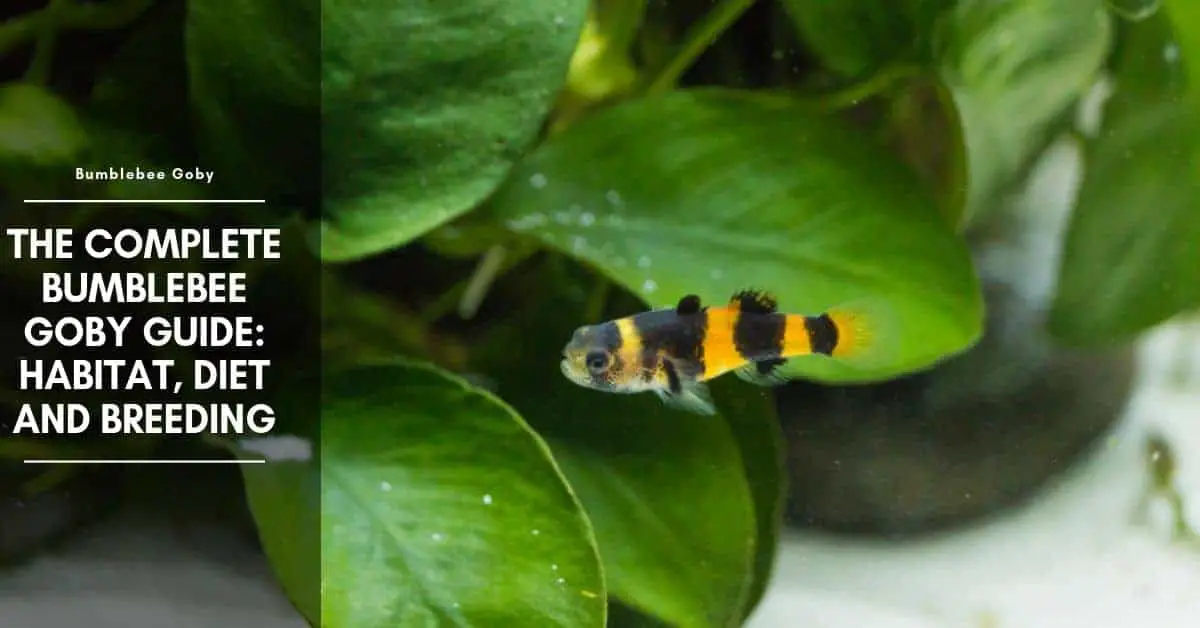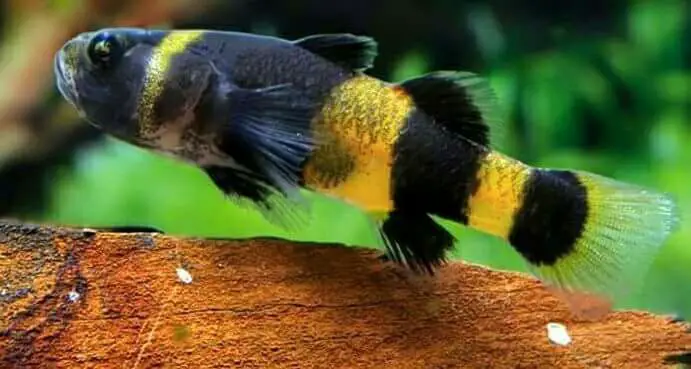Bumblebee gobies (Brachygobius) are suitable for those of you who cannot keep a large brackish water aquarium because they will be quite happy in a 10-20 gallons tank. Although these fishes are small, we do not recommend using anything smaller than this because it is more difficult to maintain good water conditions in a small body of water.
| TEMPERAMENT | Territorial by nature |
| WATER | Temperature 77–79°F (25–26°C); alkaline (pH 7.6–8.0) with SG 1.002–1.007 |
| DIET | Omnivores |
| SIZE | 1.6-2 inches |
| Tank size | Minimum 10 gallons |
Bumblebee goby species
There are two species available, bumblebee goby and golden-banded goby, but because they look very similar, both are usually labeled “bumblebee gobies” in dealers’ tanks. Both are small, 4-5 cm (1.6-2 in) in length at most, and both have broad yellow and black vertical bands on the body, but in bumblebee goby, these bands are more clearly defined. Both are found in fresh and brackish waters in Asia, but bumblebee goby has the more restricted range.
Habitat and tank requirements
Like all gobies, these fishes spend much of their time darting about among rocks and pebbles or resting on wood or leaves in the mid to lower regions of the aquarium, so design your decor with this in mind. Fine gravel makes a good base for a scattering of pebbles and rocks together with a piece of bog-wood. Attach some Java fern to the wood, and plant other salt-tolerant plants in thickets to the rear and sides of the aquarium.
Add some rocks and wood
If possible provide a cave or two, which can be half flowerpots either left just as they are or camouflaged with stones – the choice is yours, but make sure there are plenty of other hiding places because bumblebees are territorial, so it is important to have sufficient rocks, wood, and so on so that each fish can stake a claim to its own patch. Then, provided you don’t add more gobies or move the rocks around, there will be no real battles, just the fishes shaping up to each other if one inadvertently enters the territory of another.
Bumblebee goby diet
Feeding bumblebees can be quite a problem, as only rarely will they accept flake foods. If you are lucky, they will take frozen bloodworm and Daphnia, if not, then you must be prepared to provide live foods of all kinds. They are particularly fond of white worm and Tubifex, and will also take most other aquatic invertebrates. If you have limited supplies of these available, it is suggested that you also culture brine shrimps and let these grow on a little before feeding them to your fishes.
API STRESS COAT Aquarium Water Conditioner 16-Ounce Bottle
Tetra AquaSafe Plus, 8.45 Ounces, aquarium Water Conditioner And Dechlorinator, Model Number: 46798162681
$10.19 (as of December 23, 2025 11:21 GMT +03:00 - More infoProduct prices and availability are accurate as of the date/time indicated and are subject to change. Any price and availability information displayed on [relevant Amazon Site(s), as applicable] at the time of purchase will apply to the purchase of this product.)API TAP WATER CONDITIONER Aquarium Water Conditioner 16-Ounce Bottle
$8.48 (as of December 23, 2025 11:21 GMT +03:00 - More infoProduct prices and availability are accurate as of the date/time indicated and are subject to change. Any price and availability information displayed on [relevant Amazon Site(s), as applicable] at the time of purchase will apply to the purchase of this product.)Water conditions
Although they will live in hard (above 15° dH) freshwater, they really seem to prefer warm, brackish conditions. Make sure that you have an efficient filtration system as any deterioration in water conditions can cause stress and they may suffer from bacterial or fungal infections. This doesn’t mean that there has to be a torrent of water flowing through the tank – flow rate does not equate with efficiency -just a gentle turnover of the water is fine; the fishes won’t enjoy being washed away.
Bumblebee goby tank mates
Keeping these gobies in a community tank, they are not compatible with community aquariums because they need brackish water. The goby males battle for their territory on the aquarium floor, and notwithstanding this, it is recommended to have not smaller than 8 varieties in a school to make sure that they don’t show aggression towards other fish.
Bumblebee goby is compatible with different peaceful tempered fish species of the same size and ability to live in brackish water like guppies and mollies. Fishes that move in the middle water layers or near the surface are better as bumblebee goby tank mates.
Breeding bumblebee gobies
A water change with freshwater (that is, a reduction in salinity) will often provide the trigger for the fishes to spawn. Males are more colorful than females but at spawning time the females are easy to spot because they are much fuller in the body and, about 48 hours prior to spawning, will show an ovipositor. The pair will spawn either beneath a rock or in a cave, laying up to 200 eggs. At about 28°C (82°F), the eggs will hatch in four days and the male guards the fry.
At this time he will defend his brood against all comers, including the female, so she must have a hideaway to retreat to. For the first few days after the fry become free swimming, the shoal moves about the lower levels of the aquarium, but it isn’t long before they, like their parents, adopt a bottom-dwelling lifestyle. One of the problems is providing sufficient live foods. It is critical that the timing of brine shrimp hatching coincides with the fry needing it.
Bumblebee goby fry
Growth is steady provided you can supply enough live foods and plenty of space, so you will probably need to set up another tank in which to grow on the fry. Most losses seem to occur because the fry starve.
Keeping these little gobies in a species aquarium is all very well and good, but it does seem an awful waste of the top layers of the aquarium. A pair of sailfin mollies (Poecilia sp.) make excellent companions for the gobies and in brackish waters, they really show their true colors and tend not to suffer from the bacterial or fungal infections that sometimes break out on those kept in freshwater. Being opportunists, they will take the live foods put in for the gobies, but you will soon learn how much will keep both species happy.

Hi, my name is Sean, and I’m the primary writer on the site. I’m blogging mostly about freshwater and saltwater aquariums, fish, invertebrates, and plants. I’m experienced in the fishkeeping hobby for many years. Over the years I have kept many tanks, and have recently begun getting more serious in wanting to become a professional aquarist. All my knowledge comes from experience and reading forums and a lot of informative sites. In pursuit of becoming a professional, I also want to inspire as many people as I can to pick up this hobby and keep the public interest growing.
Read more about Sean.
Please join also my Facebook group.





















